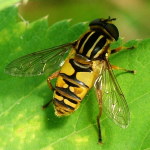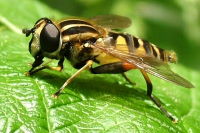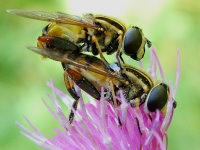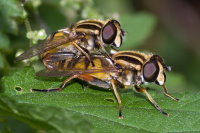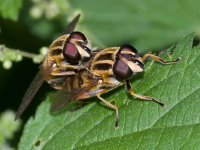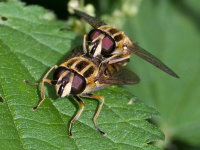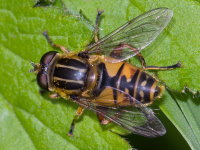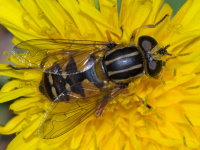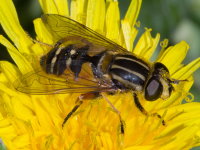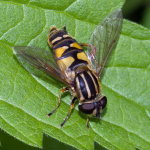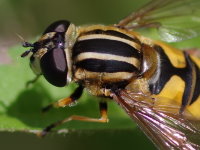Phylum Arthropoda (Arthropods) ➔ Subphylum Hexapoda (Hexapods) ➔ Class Insecta (Insects) ➔ Order Diptera (True flies) ➔ Family Syrphidae (Hoverflies)
Helophilus pendulus (Linnaeus, 1758)
Gemeine Sumpfschwebfliege Sun Fly
Synonyms and other combinations:
Helophilus similis Curtis, 1832 | Musca trelineata Harris, 1782 | Musca trileniata Harris, 1780 | Musca trilenva Harris, 1776 | Musca trilineata Harris, 1776 | Syrphus praecox Rossi, 1790 |
Classification:
Helophilus pendulus belongs to the subfamily Eristalinae, tribe Eristalini.Distribution:
From Iceland, Fennoscandia and the Faroes south to Iberia; from Ireland eastwards through central and southern Eurasia to the Pacific coast; more localised in southern Europe.Habitat:
Various habitats, with a preference for sheltered places in moist grasslands.Description:
Helophilus pendulus has a body length of 10 - 14 mm. The eyes are bald. The face has a wide, bare black central strip. The antennae are black, the third antenna segment is longer than it is wide. The hind margins of the abdomen segments 2 and 3 are narrow yellow. The hind femora are at the top to 1/3 and the hind tibia at the base half to 2/3 yellow red.Biology:
Helophilus pendulus flies in 2 generations from April to September.The larvae are not picky. They live in standing water of ponds, canals, wet ditches, open tree hollows, cow-dung, wet compost heaps and slurry pits. The larvae are called rat-tailed maggots, because they have at their posterior end a three-segmented extendable breathing siphon that allows them to breathe in an oxygen-deficient environment.
References, further reading, links:
- Pape T. & Thompson F.C. (eds) (2017). Systema Dipterorum (version 2.0, Jan 2011). In: Species 2000 & ITIS Catalogue of Life, 2017 Annual Checklist (Roskov Y., Abucay L., Orrell T., Nicolson D., Bailly N., Kirk P.M., Bourgoin T., DeWalt R.E., Decock W., De Wever A., Nieukerken E. van, Zarucchi J., Penev L., eds.). Digital resource at www.catalogueoflife.org/annual-checklist/2017. Species 2000: Naturalis, Leiden, the Netherlands. ISSN 2405-884X.
- Gerald Bothe: Bestimmungsschlüssel für die Schwebfliegen (Diptera, Syrphidae) Deutschlands und der Niederlande, DJN, 1984, ISBN 3-923376-07-3
- M.C.D.Speight: Species Accounts of European Syrphidae (Diptera), Glasgow 2011, Syrph the Net, the database of European Syrphidae, vol. 65, 285 pp., Syrph the Net publications, Dublin.
- Menno Reemer, Willem Renema, Wouter van Steenis, Theo Zeegers, Aat Barendregt, John T. Smit, Mark P. van Veen, Jeroen van Steenis, Laurens van der Leij: De Nederlandse Zweefvliegen (Diptera: Syrphidae), Nederlandse Fauna 8, 2009.
- Anasimyia interpuncta
- Anasimyia transfuga
- Baccha elongata
- Brachyopa sp.
- Brachypalpoides lentus
- Brachypalpus laphriformis
- Brachypalpus sp.
- Brachypalpus valgus
- Ceriana conopsoides
- Ceriana vespiformis
- Chalcosyrphus femoratus
- Chalcosyrphus valgus
- Cheilosia albipila
- Cheilosia albitarsis
- Cheilosia chrysocoma
- Cheilosia illustrata
- Cheilosia pagana
- Cheilosia scutellata
- Cheilosia sp.
- Chrysogaster sp.
- Chrysotoxum bicinctum
- Chrysotoxum fasciatum
- Chrysotoxum festivum
- Chrysotoxum verralli
- Criorhina berberina
- Dasysyrphus albostriatus
- Dasysyrphus sp.
- Dasysyrphus tricinctus
- Didea fasciata
- Didea intermedia
- Didea sp.
- Epistrophe diaphana
- Epistrophe eligans
- Epistrophe flava
- Epistrophe melanostoma
- Epistrophe melanostoma/nitidicollis
- Epistrophella euchroma
- Eristalinus megacephalus
- Eristalis interrupta
- Eristalis intricaria
- Eristalis lineata
- Eristalis rupium
- Eristalis similis
- Eristalis sp.
- Eumerus purpurariae
- Eumerus sp.
- Eupeodes luniger
- Eupeodes sp.
- Ferdinandea cuprea
- Helophilus hybridus
- Helophilus sp.
- Helophilus trivittatus
- Ischiodon aegyptius
- Leucozona glaucia
- Leucozona laternaria
- Leucozona lucorum
- Melangyna lasiophthalma
- Melangyna quadrimaculata
- Melangyna umbellatarum
- Melanogaster sp.
- Meligramma triangulifera
- Meliscaeva cinctella
- Merodon ambiguus
- Merodon avidus
- Merodon moenium
- Merodon obscuritarsis
- Merodon sp.
- Microdon analis/major
- Microdon mutabilis/myrmicae
- Myolepta dubia
- Orthonevra sp.
- Paragus sp.
- Parasyrphus lineolus
- Parhelophilus sp.
- Pipiza austriaca
- Pipiza bimaculata
- Pipiza fenestrata
- Pipiza sp.
- Platycheirus rosarum
- Platycheirus sp.
- Rhingia rostrata
- Scaeva albomaculata
- Scaeva selenitica
- Sericomyia lappona
- Sphaerophoria rueppelli
- Sphaerophoria sp.
- Sphegina sp.
- Spilomyia saltuum
- Syrphus sp.
- Syrphus vitripennis
- Temnostoma bombylans
- Temnostoma meridionale
- Temnostoma vespiforme
- Tropidia scita
- Xanthogramma citrofasciatum
- Xanthogramma pedissequum
- Xylota sp.
- Xylota sylvarum
- Aspen Hoverfly
- Band-eyed Drone Fly
- Black-horned Smoothtail
- Brown-toed Forest Fly
- Bumblebee Hoverfly
- Chequered Hoverfly
- Common Bog Hoverfly
- Common Drone Fly
- Common Snout-hoverfly
- Deadhead Hover Fly
- Dusky-banded Forest Fly
- European Drone Fly
- Figwort Cheilosia
- Four-spotted Pipiza
- Hornet Mimic Hoverfly
- Large Hoverfly
- Large Narcissus Fly
- Larger Spotty-eyed Drone Fly
- Long Hoverfly
- Marmalade Fly
- Migrant Hoverfly
- Orange-belted Plumehorn
- Pied Hoverfly
- Pine Hoverfly
- Snouted Duckfly
- Summer Fly
- Sun Fly
- Tapered Drone Fly
- Thick legged Hoverfly
- White-banded Drone Fly
